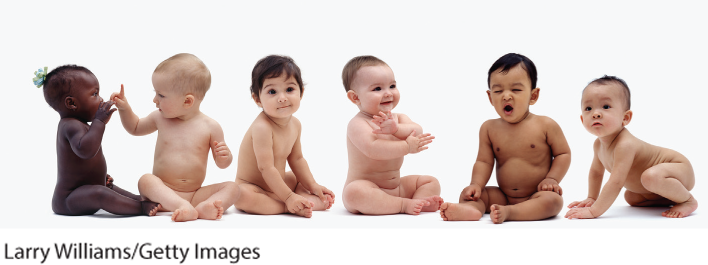Group Differences in Intelligence Test Scores
If there were no group differences in aptitude scores, psychologists would have less debate over hereditary and environmental influences. But there are group differences. What are they? And what shall we make of them?
Gender Similarities and Differences
In science as in everyday life, it is differences, not similarities, that excite interest. In worldwide studies, men estimate their own intelligence higher than do females (Furnham, 2016). Yet compared with the anatomical and physiological differences between men and women, our intelligence differences are minor. In that 1932 testing of all Scottish 11-year-olds, for example, girls’ average intelligence score was 100.6 and boys’ was 100.5 (Deary et al., 2003). So far as g is concerned, boys and girls, and men and women, are the same.
Yet, most people find differences more newsworthy. Girls outpace boys in spelling, verbal fluency, locating objects, detecting emotions, and sensitivity to touch, taste, and color (Halpern et al., 2007; Voyer & Voyer, 2014). Boys outperform girls in tests of spatial ability and complex math problems, though in math computation and overall math performance, boys and girls hardly differ (Else-Quest et al., 2010; Hyde & Mertz, 2009; Lindberg et al., 2010). Males’ mental ability scores also vary more than females’. Thus, boys worldwide outnumber girls at both the low extreme and the high extreme (Brunner et al., 2013). Boys, for example, are more often found in special education classes, but also among those scoring very high on the SAT math test.
The most reliable male edge appears in spatial ability tests like the one shown in Figure 64.1 (Maeda & Yoon, 2013; Palejwala & Fine, 2015). The solution requires speedy mental rotation of three-dimensional objects. Today, such skills help when fitting suitcases into a car trunk, playing chess, or doing certain types of geometry problems. From an evolutionary perspective, those same skills would have helped our ancestral fathers track prey and make their way home (Geary, 1995, 1996; Halpern et al., 2007). The survival of our ancestral mothers may have benefited more from a keen memory for the location of edible plants—a legacy that lives today in women’s superior memory for objects and their location.

Figure 64.1 A mental rotation test
This illustrates the type of items found on a spatial abilities test. See answer below.1
Evolutionary psychologist Steven Pinker (2005) has argued that biology affects gender differences in life priorities (women’s somewhat greater interest in people versus men’s in money and things), in risk-taking (with men more reckless), and in math reasoning and spatial abilities. Such differences are, he noted, observed across cultures, stable over time, influenced by prenatal hormones, and observed in genetic boys raised as girls.

Minding the math gap In 2014, Iranian math professor Maryam Mirzakhani (1977–2017) became the first woman to win math’s most admired award, the Fields Medal. What was her advice to people who want to know more about math? Practice patience. “The beauty of mathematics,” Mirzakhani said, “only shows itself to more patient followers” (The Guardian, 2014).
But social influences also construct gender. Researchers report that culturally influenced preferences help explain why American women, more than men, avoid math-intensive vocations (Ceci & Williams, 2010, 2011). Social expectations and divergent opportunities also shape boys’ and girls’ interests and abilities (Crawford et al., 1995; Eccles et al., 1990). In Asia and Russia, teen girls have outperformed boys in an international science exam; in North America and Britain, boys have scored higher (Fairfield, 2012). More gender-equal cultures, such as Sweden and Iceland, exhibit little of the gender math gap found in gender-unequal cultures, such as Turkey and Korea (Guiso et al., 2008; Kane & Mertz, 2012). Since the 1970s, as gender equity has increased in the United States, the boy-to-girl ratio among 12- to 14-year-olds with very high SAT math scores (above 700) has declined from 13 to 1 to 3 to 1 (Nisbett et al., 2012). And in psychology, there’s been a dramatic change in the ratio of women to men earning doctorates—from 17 percent women in 1958 to 70 percent in 2015 (Burelli, 2008; NSF, 2016). Experience matters.

“That’s an excellent suggestion, Miss Triggs. Perhaps one of the men would like to suggest it.”
Racial and Ethnic Similarities and Differences
Fueling the group-differences debate are two other disturbing but scientifically agreed-upon facts:
- Racial and ethnic groups differ in their average intelligence test scores.
- High-scoring people (and groups) are more likely to attain high levels of education and income.
There are many group differences in average intelligence test scores. New Zealanders of European descent outscore native Maori New Zealanders. Israeli Jews outscore Israeli Arabs. Most Japanese outscore most Burakumin, a stigmatized Japanese minority. And White Americans have outscored Black Americans. This Black-White difference has diminished somewhat in recent years, especially among children (Dickens & Flynn, 2006; Nisbett et al., 2012). Such group differences provide little basis for judging individuals. Worldwide, women outlive men by four years, but knowing only that you are male or female won’t tell us how long you will live.

We have seen that heredity contributes to individual differences in intelligence. But group differences in a heritable trait may be entirely environmental. Consider one of nature’s experiments: Allow some children to grow up hearing their culture’s dominant language, while others, born deaf, do not. Then give both groups an intelligence test rooted in the dominant language, and (no surprise) those with expertise in that language will score higher (Braden, 1994; Steele, 1990; Zeidner, 1990). Although individual performance differences may be substantially genetic, the group difference is not (Figure 64.2).

Figure 64.2 Group differences and environmental impact
Even if the variation between members within a group reflects genetic differences, the average difference between groups may be wholly due to environment. Imagine that seeds from the same mixture are sown in different soils. Although height differences within each window box of flowers will be genetic, the height difference between the two groups will be environmental.
Might the racial gap be similarly environmental? Consider:
Genetics research reveals that under the skin, we humans are remarkably alike. The average genetic difference between two Icelandic villagers or between two Kenyans greatly exceeds the group difference between Icelanders and Kenyans (Cavalli-Sforza et al., 1994; Rosenberg et al., 2002). Moreover, looks can deceive. Light-skinned Europeans and dark-skinned Africans are genetically closer than are dark-skinned Africans and dark-skinned Aboriginal Australians.
Race is not a neatly defined biological category. Many social scientists see race primarily as a social construction without well-defined physical boundaries, as each race blends seamlessly into the race of its geographical neighbors (Helms et al., 2005; Smedley & Smedley, 2005). In one genetic analysis of more than 160,000 people living in the United States, most with less than 28 percent African ancestry said they were White; those with more than 28 percent mostly said they were African-American (Byrc et al., 2015). Moreover, with increasingly mixed ancestries, more and more people defy neat racial categorization and self-identify as multiracial (Pauker et al., 2009).
The intelligence test performance of today’s better-fed, better-educated, and more test-prepared population exceeds that of the 1930s population—by a greater margin than the intelligence test score of the average White today exceeding that of the average Black (Flynn, 2012; Pietschnig & Voracek, 2015; Trahan et al., 2014). One research review noted that the average intelligence test performance of today’s sub-Saharan Africans is the same as that of British adults in 1948 (Wicherts et al., 2010). No one credits genetics for such generation-to-generation differences.
When Blacks and Whites have or receive the same pertinent knowledge, they exhibit similar information-processing skill. “The data support the view that cultural differences in the provision of information may account for racial differences in [intelligence test performance],” reported researchers Joseph Fagan and Cynthia Holland (2007a).
Schools and culture matter. Countries whose economies create a large wealth gap between rich and poor tend also to have a large rich-versus-poor intelligence test score gap (Nisbett, 2009). In China and Turkey, people in poorer regions have the lowest intelligence test scores, and those in wealthier regions have the highest (Lynn et al., 2015, 2016). Moreover, educational policies such as kindergarten attendance, school discipline, and instructional time per year predict national differences in intelligence and knowledge tests (Lynn & Vanhanen, 2012; Rindermann & Ceci, 2009). Math achievement, aptitude test differences, and especially grades may reflect conscientiousness more than competence (Poropat, 2014). Asian students, who have outperformed North American students on such tests, have also spent 30 percent more time in school and much more time in and out of school studying math (Geary et al., 1996; Larson & Verma, 1999; Stevenson, 1992). Women in college and university similarly outperform equally able men, thanks partly to their greater conscientiousness (Keiser et al., 2016).
In different eras, different ethnic groups have experienced golden ages—periods of remarkable achievement. Twenty-five hundred years ago, it was the Greeks and the Egyptians, then the Romans. In the eighth and ninth centuries, genius seemed to reside in the Arab world. Five hundred years ago, the Aztec Indians and the peoples of Northern Europe were the superachievers. Today, many people notice Asian technological genius and Jewish cultural success. Cultures rise and fall over centuries; genes do not. That fact makes it difficult to attribute a natural superiority to any racial or ethnic group.

World Scrabble champs In 2015, Team Nigeria was the top country in the World Scrabble Championship. Five of its six members finished among the top 50 contestants, including Wellington Jighere, center, the individual world Scrabble champion.
Moreover, consider the striking results of studies that reveal a shrinking White/Black aptitude gap over time and with more equal education (Nisbett, 2009). One national study looked back over the mental test performances of White and Black young adults after graduation from college. From eighth grade through the early high school years, the average aptitude score of the White students increased, while that of the Black students decreased—creating a gap that reached its widest point at about the time that high school students like you take college admissions tests. But during college, the Black students’ scores increased “more than four times as much” as those of their White counterparts, thus greatly decreasing the aptitude gap. “It is not surprising,” concluded researcher Joel Myerson and his colleagues (1998), “that as Black and White students complete more grades in high school environments that differ in quality, the gap in cognitive test scores widens. At the college level, however, where Black and White students are exposed to educational environments of comparable quality . . . many Blacks are able to make remarkable gains, closing the gap in test scores.”